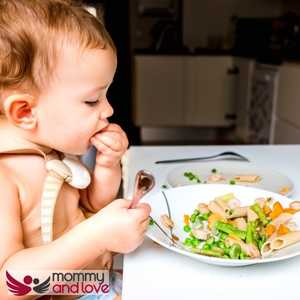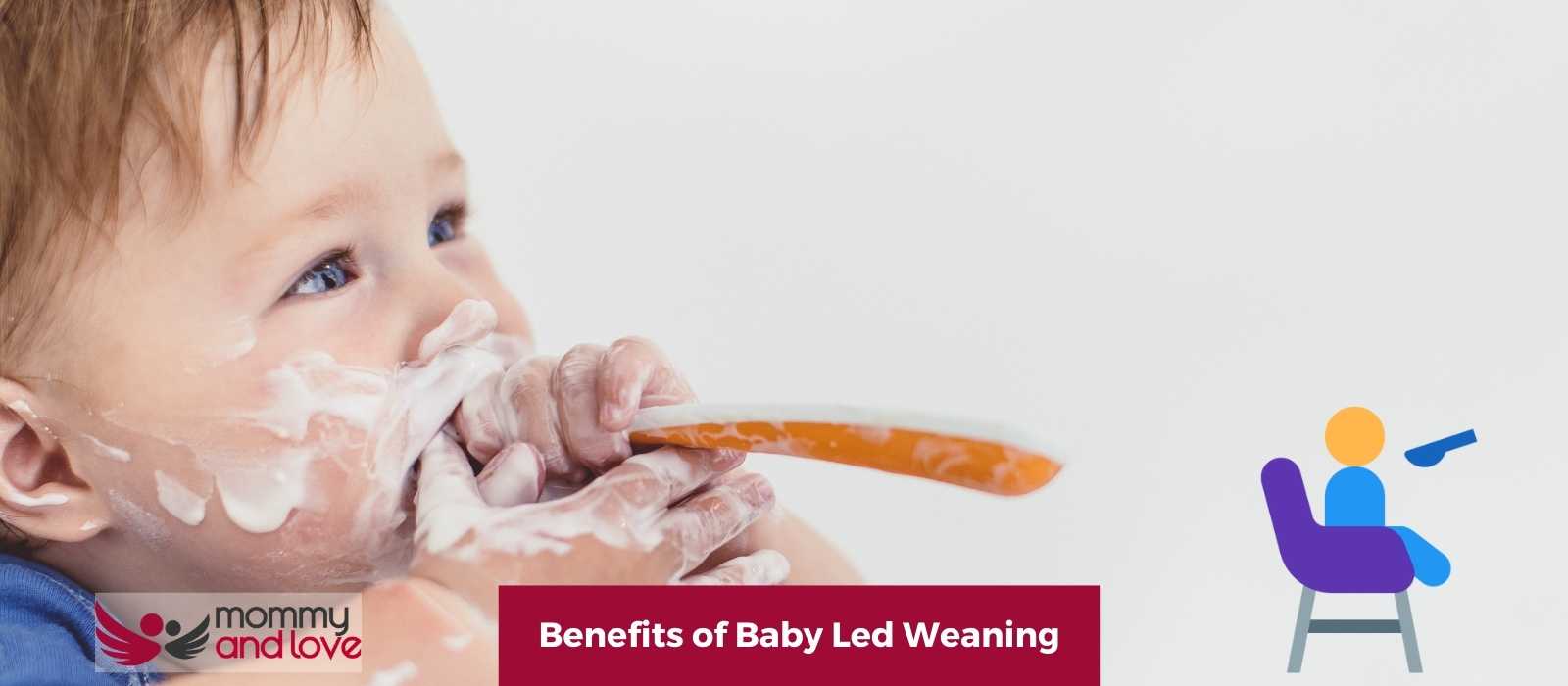You may have heard about baby-led weaning, but do you (a) know exactly what it is and (b) are you aware of the benefits that it can bring to your baby?
What is Baby Led Weaning?

Put simply, baby-led weaning is all about offering your baby a selection of solid foods to choose from – and letting them feed themselves.
If you’d like to try the practice, then your baby will need to be able to grasp whole pieces of baby food and bring them to their mouth for self-feeding.
The recommended age to start baby-led weaning is from six months onwards: the same age as the alternative – spoon-feeding. We’ve done a full guide to baby led weaning here.
How To Start Baby Led Weaning
If you feel your baby is ready and its time to start introducing solid foods, start by sitting your baby upright facing the table. We’ve done a handy guide as to signs a baby is ready for weaning. You can do this by placing your baby either on your lap or in a highchair.
Ensure that they are steady and that their hands and arms have free movement. Make sure they have an interest in foods and when offered they don’t automatically do the tongue thrust reflex. You can start baby led weaning even if your baby does not have teeth.
Begin by offering your baby little sticks and chunks of food. From our experience, foods such as cooked sweet potato, banana and unsalted breadsticks are particularly popular with babies, but you can try a wide range of foods and see what works with your baby. Your baby will explore food at his own pace.
Baby-led Weaning Benefits
Oh, where do we start, there are so many baby led weaning pros!?
In addition to the fact that baby-led weaning allows your baby to be offered the same food that the rest of the family is eating, most moms we’ve spoken to have said that babies, who choose what to feed themselves, often have a fantastic range of food tastes.
Baby-led weaning allows your baby to get used to different food textures from a very early age, so they’re more likely to be happy to try different foods – although there isn’t much research at the moment about whether baby-led weaning prevents a baby from becoming a fussy eater.
There is research that shows that babies who feed themselves are more likely to control their appetite, so this would indicate that such babies will have a reduced risk of obesity in later life: a fact that is vitally important given the current obesity and overweight statistics!
The nature of the foods that are used during baby-led weaning mean that your baby can enjoy good, nutritious food as they grow up, but, health benefits apart, here are just some of the other benefits that baby-led weaning can give your baby…..
Education, education, education!

The simple fact is that babies are always learning and, by handling food, they can learn so much.
By holding something soft without squashing it, or something slippery without dropping it, will teach your baby about the concepts of size, shape, weight, texture and about ‘less and more’.
Every one of their five senses (sight, touch, hearing, smell, and taste) are involved in baby-led weaning, helping them to have a better understanding of the world around them. Its also more social as they become a full part of family meals, sitting down with the whole family and eating the same foods, rather than separate soft foods being spoon fed.
Fun, fun, fun!
Everyone should enjoy what food and eating have to offer, and babies are no different. Being able to be in control of what they eat – and how much – will bring your baby so much fun. In addition to the fact that they’re able to join with parents and siblings at the table, your baby will enjoy learning about different foods and about doing things for themselves.
Happy, stress-free mealtimes will give your baby a healthier attitude towards food when they start eating solid foods.
Helps your baby reach their potential
Development is one of the ‘buzz’ words for your baby throughout this important time and so it’s vitally important that feeding themselves allows them to practice important aspects of their development at every mealtime.
Just by using their fingers to get food to their mouths means they can practice hand-eye coordination, while gripping foods of different sizes and textures several times a day improves their dexterity. Baby led feeding teaches them not just to self feed but also gives them vital hand eye coordination.
Being part of family mealtimes
By the time your baby reaches the age of 6 months, they’ll be more sociable and won’t take kindly to be put in the corner with their own food. With baby-led weaning, babies are included in family mealtimes from the start, eating the same food and joining in the social time.
This is nothing but fun for your baby and allows them to copy mealtime behavior. By watching other members of the family use their cutlery, your baby will get to learn very quickly how to use them and will be able to adopt the table manners expected in her family.
Your family grocery budget won’t increase as you don’t need special baby food just for baby for spoon feeding, your baby picks from what you are cooking for the whole family. Many babies prefer to feel a full part of the family meal time like this.
Learning about food

In these days of obesity and overweight – even in babies and young kids – babies who are allowed to take part in baby-led weaning are better able to learn about the look, smell, taste, and texture of different foods.
With baby-led weaning, babies can discover the different taste between a chicken and vegetable casserole, and, gradually, they’ll begin to learn how to recognize foods they like. Nutritious foods as well as a wide range of diverse foods can be given with no pressure, leading to a happy and confident eater.
Long-term health
If your baby is exposed to baby-led weaning, you’ll find that their milk feedings are gradually reduced. Babies who are breastfed, however, are more likely to continue getting a good intake of breast milk for longer.
Breastfeeding not only provides a perfect balance of nutrients, but also protection against many serious illnesses.
When it comes to introducing allergenic foods, we’ve done a complete guide on this, but the general advice isthat research suggests not to avoid foods that may trigger an food allergies, rather to give them when you are introducing solids. Clearly introduce one at a time and keep a food diary to track how different foods may your baby react.
No need for games or tricks
Can there be any parent who at one point or another hasn’t done the ‘choo choo’ spoon into the mouth? Many moms, who spoon feed their baby and who find that they’re not keen to eat, have to resort to a series of tricks and games to get their baby to eat.
With baby-led weaning, your baby can choose what they want to eat (or not!) and they will stop eating when they’re no longer hungry. This means there is no need for games involving train and aeroplane noises to try to fool a baby into accepting food that they simply don’t want!
There’s also no need to cut food into special ‘shapes’. ‘Chicken teddies’? What’s that all about? Nor will there be any need to ‘hide’ healthy ingredients such as veg in other dishes. Much more open processes that will give your baby confidence in what – and how – they eat. Their eating habits will be a lot healthier going forward.
The Take-Away on the Benefits of Baby-Led weaning
When your baby is ready to start eating solid food and you want to introduce solids, then doing the baby-led weaning route has many many benefits for parents and babies alike. BLW babies don’t need separate meals, their chewing skills and fine motor skills are enhanced and family mealtime can be a more pleasurable experience.
As long as you give a wide range of foods, including iron-rich foods as finger foods, your baby can investigate how different flavors combine. Whether you mix sweet potatoes with cow’s milk, whole grapes with greek yogurt, or ensure certain foods are included, your baby can enjoy foods at their own pace and self regulate when they are starting solids.
They are going on an adventure with new foods and a baby led approach means they have both appetite control, and you are less likely to have fussy eaters. It’s important to ensure that they have developmental readiness and that their first foods are the same size as their index finger to help prevent choking hazards.

This article was written by Sandra Baker – full time writer and the mother of four amazing kids (including twins!)
She’s also a breastfeeding counselor and has spent years helping new parents learn how to care for their children. When she’s not writing or caring for her children, Sandra likes to spend time reading and taking walks with her husband.




